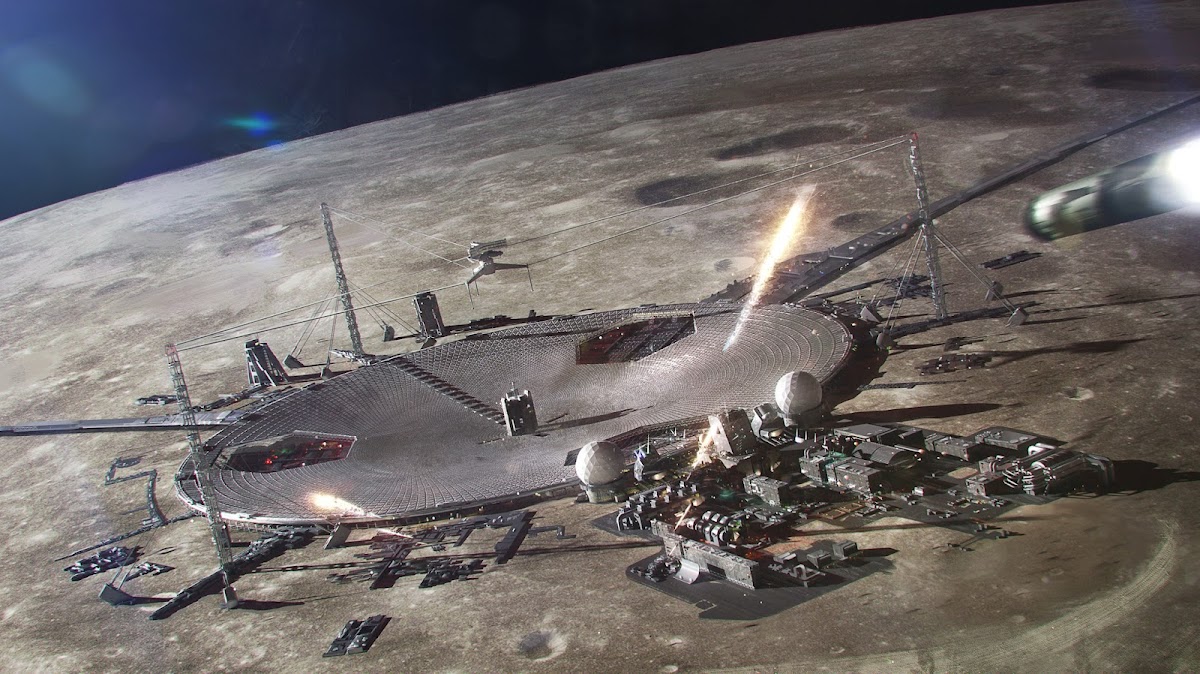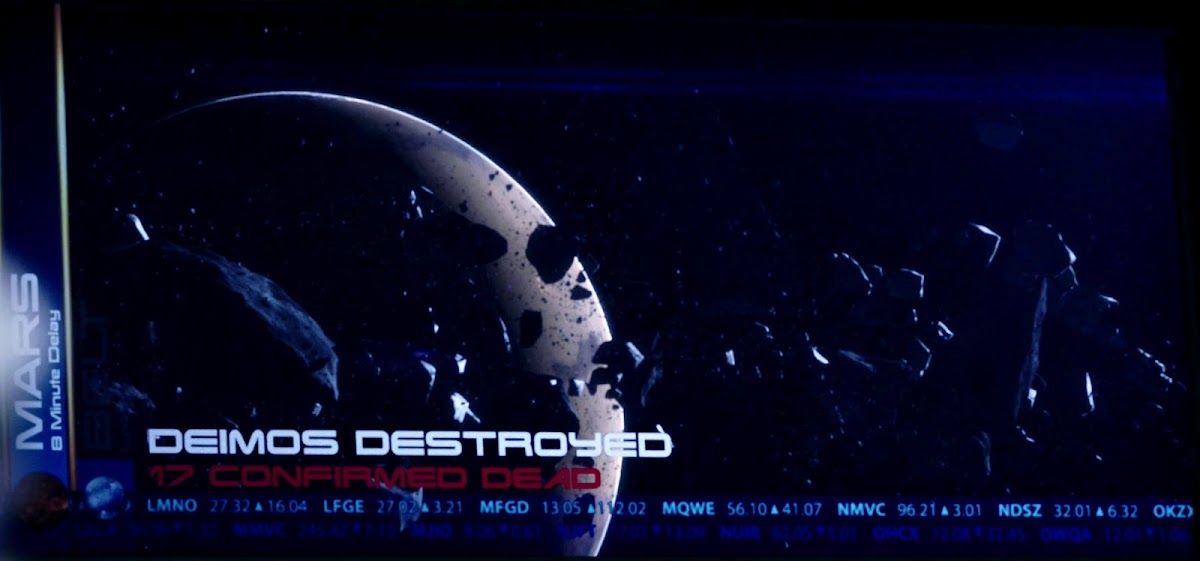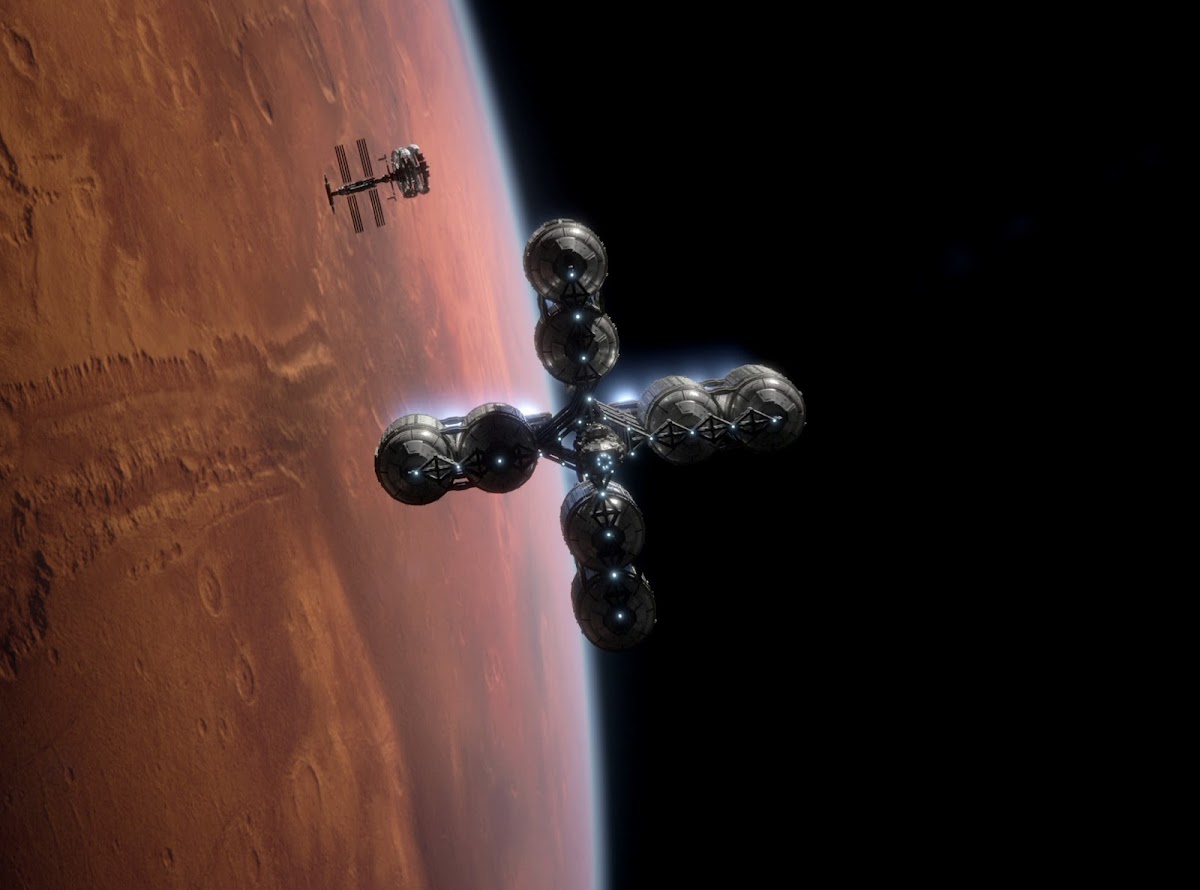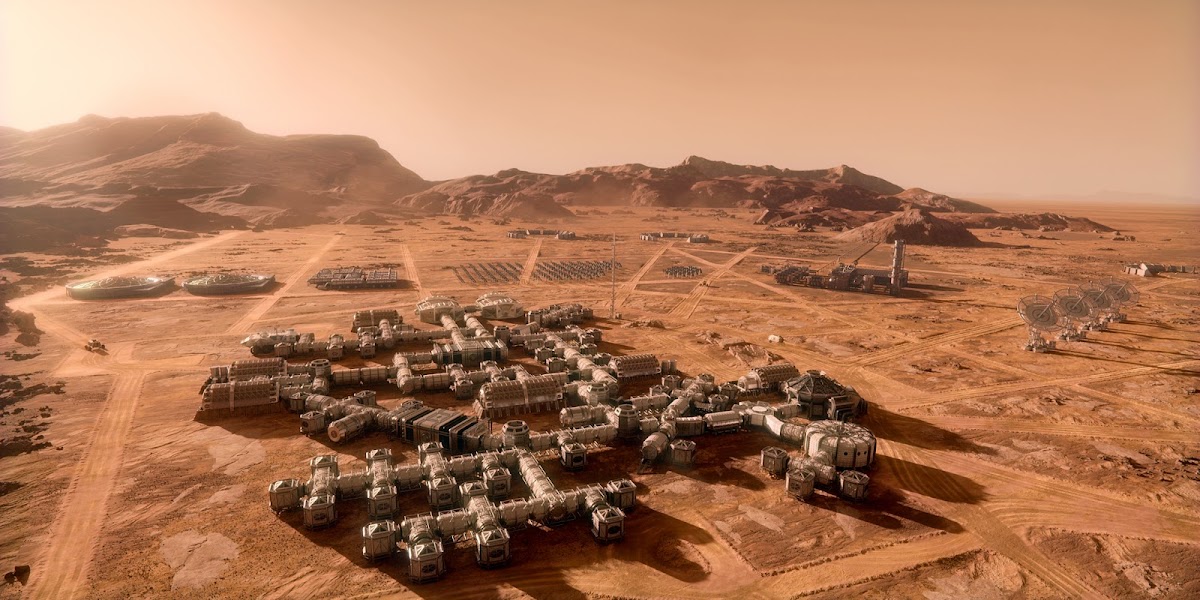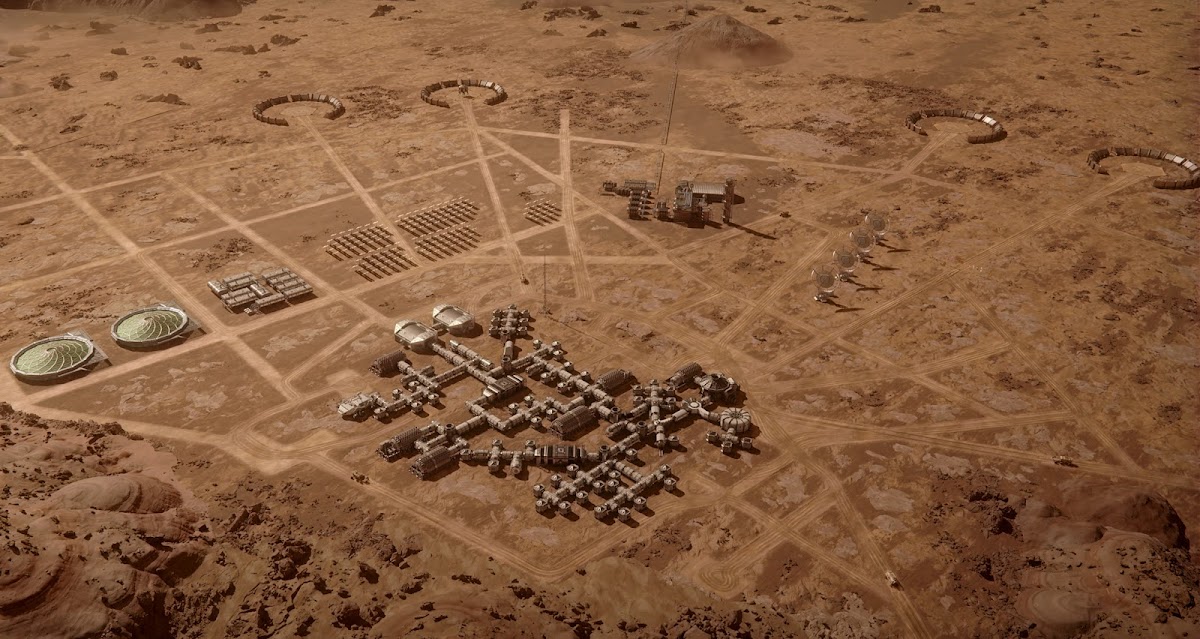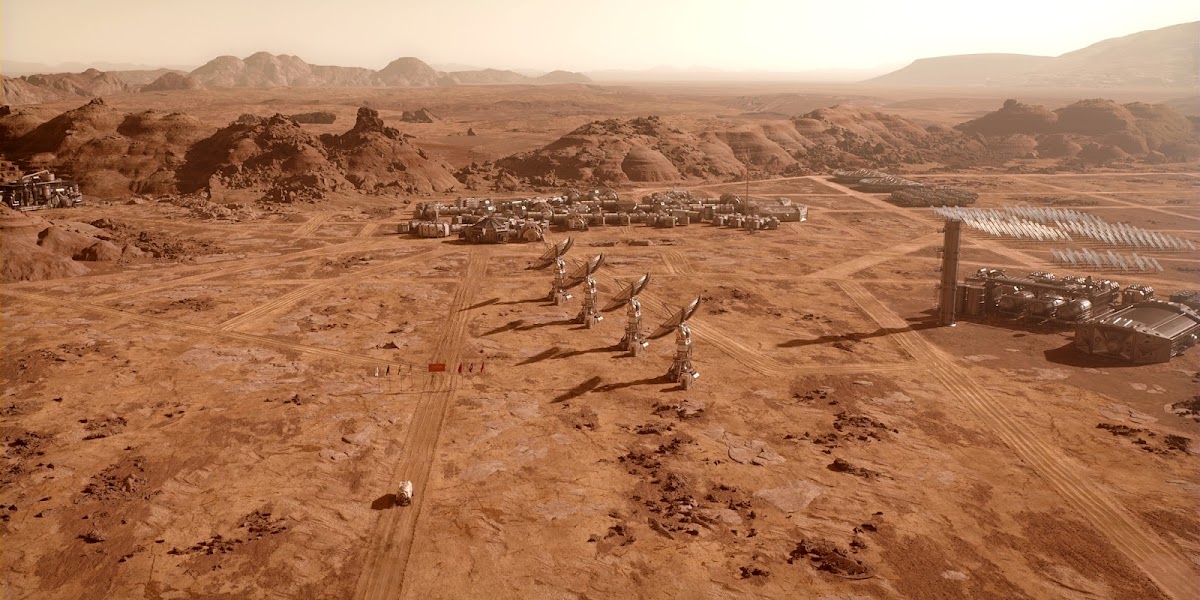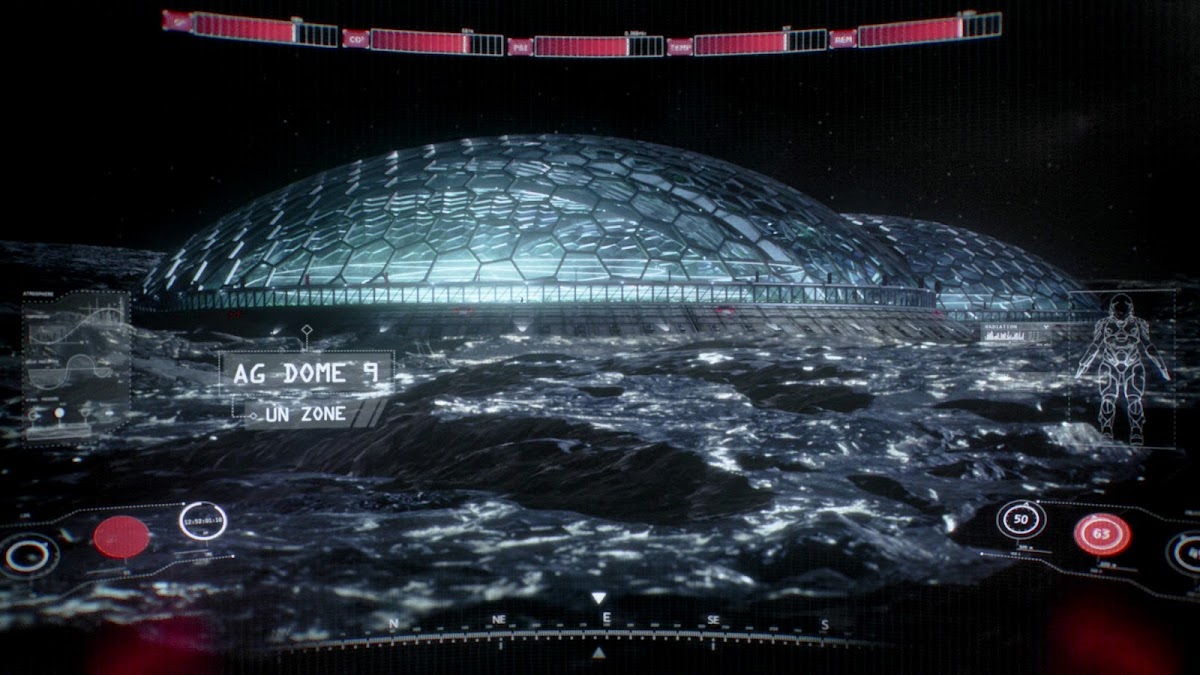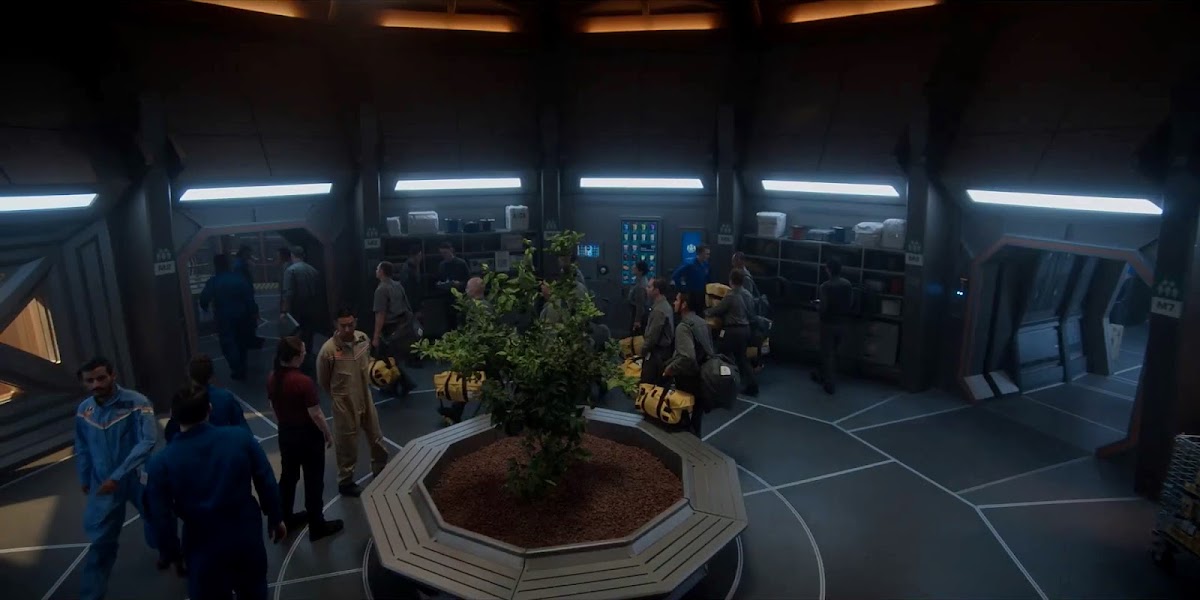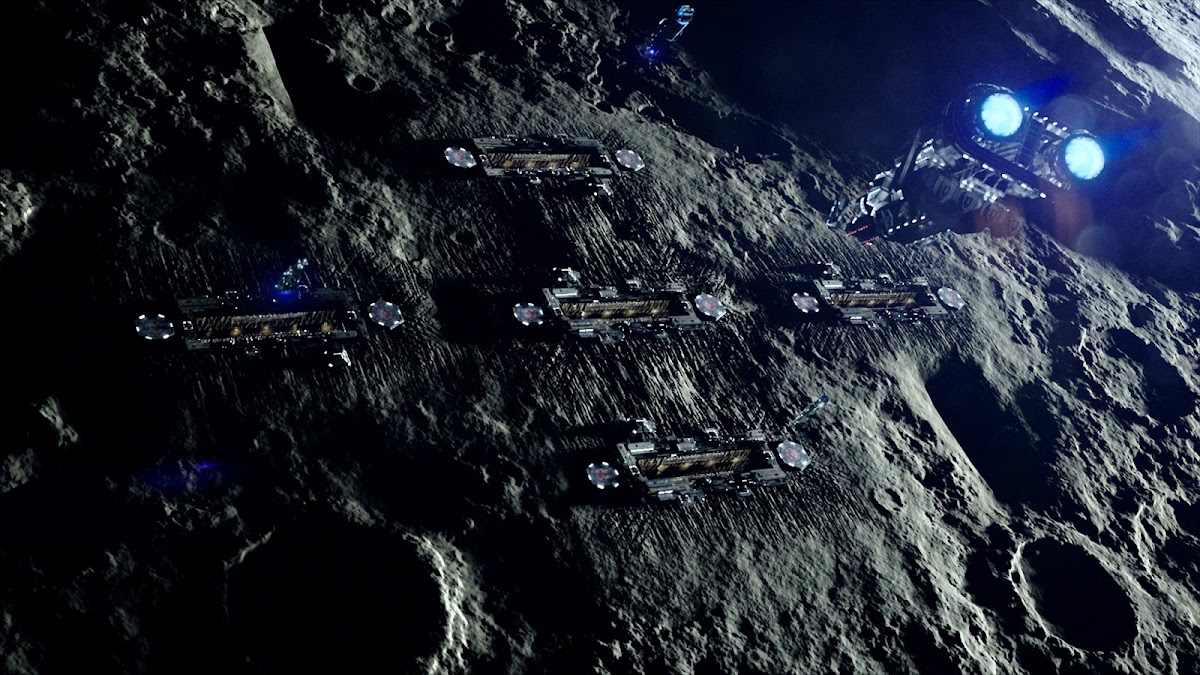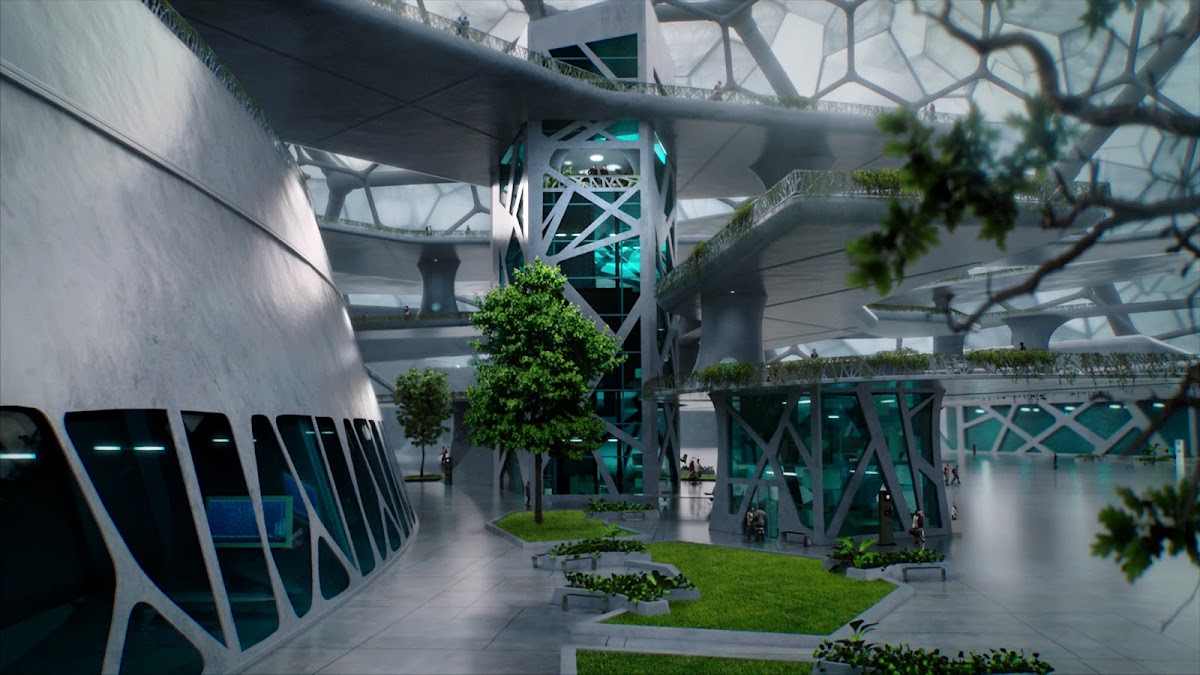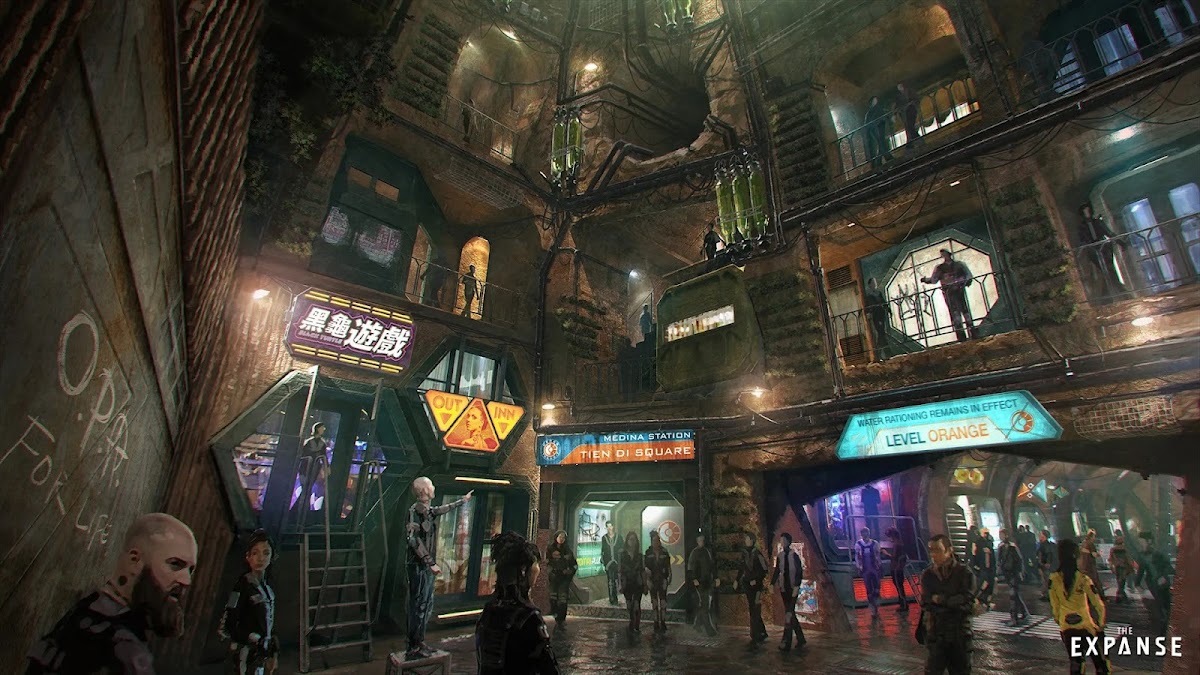Here is a collection of concept art for the Lovell city by Canadian designer Lee Fitzgerald:
Showing posts with label Science Fiction. Show all posts
Showing posts with label Science Fiction. Show all posts
Saturday, January 25, 2025
Lovell city on the Moon in "The Expanse" TV series - concept art by Lee Fitzgerald
After the bombardment of Earth Lovell City on Luna (the Moon) became the de facto capital of United Nations, one of the three competing powers in universe of The Expanse TV series - a political sci-fi drama set a few centuries in the future where humans have colonized the entire Solar system. Luna functions as a way station between Earth and the rest of the Solar system, and its spaceport at Lovell City serves as a natural meeting place between residents of the inner planets and Belters. Due to its lower gravity, Luna is the only body in the inner system that Belters can easily visit. UN citizens living on Luna are generally wealthier than most of their counterparts on Earth.
Monday, December 30, 2024
New Year's Eve fireworks at a Martian colony
Celebrating New Year's Eve with fireworks at a human colony on Mars - a screenshot from 2022 science fiction teen comedy "Moonshot" set in 2049 when trips to Mars has become routine for skilled or wealthy people.
Saturday, August 3, 2024
The colonization of Mars in "The Martian Chronicles" (1980) TV series
The Martian Chronicles is a 1980 television 3-episode miniseries based on Ray Bradbury's 1950 science fiction novel with the same name The Martian Chronicles which was originally not written as a singular work but as short stories published separately in late 1940s.
The novel and TV series chronicles the exploration and settlement of Mars, the home of indigenous Martians, at the beginning of 21st century when human settlers leave the troubled Earth that is eventually devastated by a nuclear war. The series depicts Mars as having a "thin atmosphere" which humans can breathe, with desert-like vegetation and water-filled canals, cities and other alien structures built by the indigenous Martians thousands of years ago.
The Martian Chronicles TV series, aired on 1980, is one of the few works of science fiction to depict Mars, in the period between the initial Mars enthusiasm that ended in the 1960s, characterized by fear of hostile Martians, and the revival of Mars-related science fiction in the 2000s already without the Martians.
The Martian Chronicles are divided into three parts / episodes:
The novel and TV series chronicles the exploration and settlement of Mars, the home of indigenous Martians, at the beginning of 21st century when human settlers leave the troubled Earth that is eventually devastated by a nuclear war. The series depicts Mars as having a "thin atmosphere" which humans can breathe, with desert-like vegetation and water-filled canals, cities and other alien structures built by the indigenous Martians thousands of years ago.
The Martian Chronicles TV series, aired on 1980, is one of the few works of science fiction to depict Mars, in the period between the initial Mars enthusiasm that ended in the 1960s, characterized by fear of hostile Martians, and the revival of Mars-related science fiction in the 2000s already without the Martians.
The Martian Chronicles are divided into three parts / episodes:
- The Expeditions - the exploration of Mars begins with two failed expeditions. Colonel Wilder then leads a 3rd crew to discover the secret of Mars - only to find all the Martians dead from chicken pox.
- The Settlers - with native Martians wiped out by disease, thousands of humans now colonize the red planet and attempt to create a second Earth.
- The Martians - with Earth destroyed in a nuclear war, there are only a few survivors on Mars, including Wilder's family. To rebuild what he has lost, Wilder chooses to make Mars his new home.
First expeditions to Mars:
Saturday, July 20, 2024
A long night on Mars in "Fort Solis" thriller game
Fort Solis (2023) is a cinematic narrative-driven science fiction thriller game set in 2080 on Mars. During a night engulfed in a severe sandstorm two mining engineers, Jack and Jessica, respond to an unusual emergency alert from a mining and research station "Fort Solis". The station is on lockdown and seems to be abandoned. The pair separately starts to investigate, what has happened in the base, searching for clues throughout the claustrophobic buildings. Piece by piece they unlock both the various parts of the base and the truth behind recent events there. The game starts as a detective and ends as a thriller.
Fort Solis runs on Unreal Engine 5.2 so visually it is really good, especially the character models and animations. The game is not long, you can finish it in 5 to 8 hours even when reading, watching and listening to all of the clues throughout the base. The story will unfold linearly piece by piece, but there are two separate endings possible in the final act of the game.
Fort Solis runs on Unreal Engine 5.2 so visually it is really good, especially the character models and animations. The game is not long, you can finish it in 5 to 8 hours even when reading, watching and listening to all of the clues throughout the base. The story will unfold linearly piece by piece, but there are two separate endings possible in the final act of the game.
Visual recap of Fort Solis' STORY
Jack and Jessica are working at a mining rig on Mars
When receiving the emergency allert Jack is driving to the mining station "Fort Solis"
"Fort Solis" is on lockdown
Sunday, June 30, 2024
Pallas, the origin of the Free Navy, in "The Expanse" TV series
 Pallas, located in the Main Asteroid Belt between the orbits of Mars and Jupiter, is the third-largest asteroid in the Solar System (~512km in diameter). It has 22% the mass of Ceres, the largest asteroid in the Solar System, and gravity of 0.021g (2,1% of the gravity force on Earth). With an orbital inclination of 34.8°, Pallas's orbit is unusually highly inclined to the plane of the Asteroid Belt, making Pallas harder to reach by spacecraft.
Pallas, located in the Main Asteroid Belt between the orbits of Mars and Jupiter, is the third-largest asteroid in the Solar System (~512km in diameter). It has 22% the mass of Ceres, the largest asteroid in the Solar System, and gravity of 0.021g (2,1% of the gravity force on Earth). With an orbital inclination of 34.8°, Pallas's orbit is unusually highly inclined to the plane of the Asteroid Belt, making Pallas harder to reach by spacecraft.
In the universe of The Expanse TV series (a political sci-fi drama set in mid-24th century when humans have colonized the entire Solar system) Pallas hosts one of the oldest stations, Pallas Station, in the outer planets, refinement stations for the mining operations in the Asteroid Belt and the largest fuel refinery in the Belt.
In The Expanse TV series Pallas has a population of 9 to 13 thousand, but is also known for its extremist Belter splinter groups among its colony. One of those splinter groups eventually form the core of the Free Navy. Pallas is the birthplace of Marco Inaros, Naomi Nagata and their son Filip.
In late season 5 of the show the acting Secretary-General of the United Nations David Paster orders an uncoordinated missile strike against the Pallas Station, destroying one of its habitation rings and killing thousands of Belters.
Here you can view some of the few shots of Pallas Station exteriors in the show:
Naomi Nagata's ship at Pallas Station docks:
Destruction of one of the habitation rings of the Pallas Station:
More content from The Expanse TV series:
- Concept art for Lovell city (on Luna)
- Destruction of Deimos
- Ganymede, the breadbasket of the Belt
- Ceres, the capital of the Belt
- Lunar colony in season 5
- Martian colonies in season 5
- Martian colonies in season 4
- Mars in season 2
Wednesday, May 8, 2024
Destruction of Deimos in "The Expanse" TV series
 Deimos is the smaller and outer of the two natural satellites of Mars, the other being Phobos. Deimos, likely an asteroid captured by Mars' gravity, is highly non-spherical with a mean diameter of 12.5 km (about 57% the size of Phobos) and it orbits 23,460 km from Mars (Deimos' orbit is slowly getting larger and it is expected to eventually escape Mars' gravity). Escape velocity from the surface of Deimos is only 5.6 m/s so a human can basically jump off of it.
Deimos is the smaller and outer of the two natural satellites of Mars, the other being Phobos. Deimos, likely an asteroid captured by Mars' gravity, is highly non-spherical with a mean diameter of 12.5 km (about 57% the size of Phobos) and it orbits 23,460 km from Mars (Deimos' orbit is slowly getting larger and it is expected to eventually escape Mars' gravity). Escape velocity from the surface of Deimos is only 5.6 m/s so a human can basically jump off of it.
In the universe of The Expanse TV series (a political sci-fi drama set in mid-24th century when humans have colonized the entire Solar system) Deimos hosts military facilities and a deep radar station for Martian Congressional Republic - one of the three competing powers in The Expanse, along with the United Nations (based on Earth) and the Belt.
Concept art of Deimos in The Expanse by Canadian designer Lee Fitzgerald:
In early season 2 of The Expanse Deimos is destroyed with nuclear missiles in a "moon for a moon" retaliatory strike by the United Nations (Earth) after the Martian assault cruiser destroyed Earth's research base on Saturn's moon Phoebe along with the consequent destruction of the moon itself. The destruction of Deimos killed 17 Martians and the moon disintegrated forming the "Deimos Ring" around Mars.
Concept art of Martian Deep Radar Station on Deimos before the missile strike by Lee Fitzgerald:
News coverage of the destruction of Deimos:
Sunday, January 14, 2024
How to steal an asteroid .. "For All Mankind" season 4
It's possible our judgement is biased towards Mars-related content, but season 4 of For All Mankind alternate history sci-fi TV series is show's most exciting season yet. In season 4, depicting the alternate 2003, the international Happy Valley Base, founded in 1995 during season 3, has been significantly expanded and there are around 200 people living in it. We made a separate article with a large collection of high resolution shots depicting the exterior and interior of Happy Valley Base:
Mars base for 200 people in For All Mankind season 4
The main theme in season 4 is increasingly diverging visions for the purpose of human presence on Mars. For some it's only another contract job, but for others Mars is a new place to call "home". Add to the mix a once-in-a-lifetime opportunity to get hold on a large lithium-rich asteroid and increasingly strained relationships between the "upper class" (astronauts / cosmonauts, scientists and top executives) and contract workers literally living underground, and you have a recipe for a "Martian rebellion".
For All Mankind is exploring the idea of never ending space race if Soviets would have beaten US in the race for the Moon and the intention of the show is each season to jump about a decade further into the increasingly diverging reality of the show: in season 1, depicting alternate 1969 to 1974, both Soviets and US start building their separate bases near the lunar South pole; in season 2 (1983) both bases have been expanded and the superpowers compete for resources on the Lunar surface; in season 3 (1992 to 1995), Soviets and US are joined by a private company Helios and North Korea for a four way race to be first on Mars; in season 4 (2003) there is a sprawling international human base on Mars and an unexpected side enters the race to get hold on a large, lithium-rich asteroid for mining. You can watch the show on Apple TV+
Ahead there is a VISUAL RECAP OF SEASON 4, consisting of high resolution shots, downscaled from 4K UHD screens for better image quality. Be aware of heavy spoilers, revealing major story plots:
Mars base for 200 people in For All Mankind season 4
The main theme in season 4 is increasingly diverging visions for the purpose of human presence on Mars. For some it's only another contract job, but for others Mars is a new place to call "home". Add to the mix a once-in-a-lifetime opportunity to get hold on a large lithium-rich asteroid and increasingly strained relationships between the "upper class" (astronauts / cosmonauts, scientists and top executives) and contract workers literally living underground, and you have a recipe for a "Martian rebellion".
For All Mankind is exploring the idea of never ending space race if Soviets would have beaten US in the race for the Moon and the intention of the show is each season to jump about a decade further into the increasingly diverging reality of the show: in season 1, depicting alternate 1969 to 1974, both Soviets and US start building their separate bases near the lunar South pole; in season 2 (1983) both bases have been expanded and the superpowers compete for resources on the Lunar surface; in season 3 (1992 to 1995), Soviets and US are joined by a private company Helios and North Korea for a four way race to be first on Mars; in season 4 (2003) there is a sprawling international human base on Mars and an unexpected side enters the race to get hold on a large, lithium-rich asteroid for mining. You can watch the show on Apple TV+
Ahead there is a VISUAL RECAP OF SEASON 4, consisting of high resolution shots, downscaled from 4K UHD screens for better image quality. Be aware of heavy spoilers, revealing major story plots:
During season 4 interplanetary ships don't land directly on Mars; instead they dock to Phoenix, orbiting Mars, and the rest of the trip is made via small shuttles heading down to the surface:
Ed and Svetlana flying the asteroid capture ship Ranger:
Season 4 starts with an unsuccessful asteroid capture mission:
Wednesday, January 10, 2024
Mars base for 200 people in "For All Mankind" season 4
Season 4 of For All Mankind alternate history sci-fi TV series, depicting alternate 2003, "is really about the building of a new civilization on Mars" by the words of the co-creator of the series Ben Nedivi. The international Happy Valley Base, founded in 1995 during season 3 and located in Melas Chasma in the Valles Marineris canyon system on Mars, has been significantly expanded and there are around 200 people living in the base during season 4. The base is financed and operated by Mars-7 Alliance (consisting of US, USSR, ESA, North Korea, India, Japan, and the Coalition of Communist Countries for Spaceflight (CCCS)) and maintained by a private company Helios Aerospace.
Ground level of the base features several separate facilities for power generation, communications, fuel refinement, regolith processing, algae production, storage etc. and a central interconnected cluster of modules consisting of the Entrance hall for new arrivals with airlocks for the rovers, control rooms, laboratories, hydroponic farms, meeting rooms, warehouses / garages, a cafeteria, as well as the quarters for higher level personnel and astronauts / cosmonauts. The base has 5 underground sublevels, of which level 4 & 5 are still under construction in 2003 and not accessible. The sublevels house maintenance and storage rooms and additional quarters for workers. There is also a separate North Korean sector accessible only to North Koreans. The base also operates six landing pads for their orbital Hopper shuttles.
The design of the Happy Valley Base in For All Mankind is the most plausible design of a mid-sized human base on Mars that we have ever seen in a TV series or film.
For All Mankind is exploring the idea of never ending space race if Soviets would have beaten US in the race for the Moon and the intention of the show is each season to jump about a decade further into the increasingly diverging reality of the show: in season 1, depicting alternate 1969 to 1974, both Soviets and US start building their separate bases near the lunar South pole; in season 2 (1983) both bases have been expanded and the superpowers compete for resources on the Lunar surface; in season 3 (1992 to 1995), Soviets and US are joined by a private company Helios and North Korea for a four way race to be first on Mars; in season 4 (2003) there is a sprawling international human base on Mars and an unexpected side enters the race to get hold on a large, lithium-rich asteroid for mining.
Here we collected high resolution shots from season 4 (downscaled from 4K UHD screens for better image quality) depicting the exterior and interior of Happy Valley Base on Mars. No images revealing major story plots are included. We will make a separate article with season 4 story spoilers after the last episode will be released on January 12. [UPDATED:]
How to steal an asteroid .. "For All Mankind" season 4
Ground level of the base features several separate facilities for power generation, communications, fuel refinement, regolith processing, algae production, storage etc. and a central interconnected cluster of modules consisting of the Entrance hall for new arrivals with airlocks for the rovers, control rooms, laboratories, hydroponic farms, meeting rooms, warehouses / garages, a cafeteria, as well as the quarters for higher level personnel and astronauts / cosmonauts. The base has 5 underground sublevels, of which level 4 & 5 are still under construction in 2003 and not accessible. The sublevels house maintenance and storage rooms and additional quarters for workers. There is also a separate North Korean sector accessible only to North Koreans. The base also operates six landing pads for their orbital Hopper shuttles.
The design of the Happy Valley Base in For All Mankind is the most plausible design of a mid-sized human base on Mars that we have ever seen in a TV series or film.
For All Mankind is exploring the idea of never ending space race if Soviets would have beaten US in the race for the Moon and the intention of the show is each season to jump about a decade further into the increasingly diverging reality of the show: in season 1, depicting alternate 1969 to 1974, both Soviets and US start building their separate bases near the lunar South pole; in season 2 (1983) both bases have been expanded and the superpowers compete for resources on the Lunar surface; in season 3 (1992 to 1995), Soviets and US are joined by a private company Helios and North Korea for a four way race to be first on Mars; in season 4 (2003) there is a sprawling international human base on Mars and an unexpected side enters the race to get hold on a large, lithium-rich asteroid for mining.
Here we collected high resolution shots from season 4 (downscaled from 4K UHD screens for better image quality) depicting the exterior and interior of Happy Valley Base on Mars. No images revealing major story plots are included. We will make a separate article with season 4 story spoilers after the last episode will be released on January 12. [UPDATED:]
How to steal an asteroid .. "For All Mankind" season 4
Wednesday, December 13, 2023
Ganymede, the breadbasket of the Belt, in "The Expanse" TV series
Ganymede is one of the "Galilean moons" of Jupiter and the largest moon in the Solar System. It's only slightly smaller than Mars, but with only half the density, its gravity is actually weaker than the Moon's. Ganymede is the only moon with any magnetosphere thus having the ability to deflect charged ionizing radiation. In the universe of The Expanse TV series (a political sci-fi drama set in mid-24th century when humans have colonized the entire Solar system) Ganymede acts as the breadbasket of the Belt - one of the three competing powers in The Expanse, along with the United Nations (based on Earth) and Mars.
In the universe of The Expanse Ganymede has millions of residents and Ganymede Station was one of the first permanent human settlements in the outer planets, built as a long term colony with large domes filled with food crops. Large mirrors were placed around the moon to supply the Sun's light to the surface for crop growth. It was known as the safest station in the Jovian system, and many humans from other colonies traveled to Ganymede to deliver their babies, as the magnetosphere helps claim the Jovian moon the lowest amount of birth defects and stillbirths. Initially, at the start of the series, Ganymede is divided between the United Nations and Mars.
The life on Ganymede is depicted in season 2 of The Expanse. Here you can view some of the best shots from Ganymede (downscaled from 4K UHD screens for better image quality) as well as some concept art for it.
In the universe of The Expanse Ganymede has millions of residents and Ganymede Station was one of the first permanent human settlements in the outer planets, built as a long term colony with large domes filled with food crops. Large mirrors were placed around the moon to supply the Sun's light to the surface for crop growth. It was known as the safest station in the Jovian system, and many humans from other colonies traveled to Ganymede to deliver their babies, as the magnetosphere helps claim the Jovian moon the lowest amount of birth defects and stillbirths. Initially, at the start of the series, Ganymede is divided between the United Nations and Mars.
The life on Ganymede is depicted in season 2 of The Expanse. Here you can view some of the best shots from Ganymede (downscaled from 4K UHD screens for better image quality) as well as some concept art for it.
Inside an agricultural dome on Ganymede:
Magnetosphere protects Ganymede from Jupiter's harsh radiation belt:
A ship landing at a human colony on Ganymede:
Concept art for a Ganymede greenhouse by Romain Jouandeau:
Wednesday, November 8, 2023
Building a new civilization on Mars in "For All Mankind" season 4
 Yesterday Apple TV+ released yet another video revealing more details about the upcoming season 4 of For All Mankind alternate history sci-fi TV series. As the co-creator of the series Ben Nedivi states in this featurette: "This season is really about the building of a new civilization on Mars. Last year in season 3 you saw the first explorers arrive on Mars. This season you're actually seeing hundreds of people up there and you're seeing, how civilization becomes civilization".
Yesterday Apple TV+ released yet another video revealing more details about the upcoming season 4 of For All Mankind alternate history sci-fi TV series. As the co-creator of the series Ben Nedivi states in this featurette: "This season is really about the building of a new civilization on Mars. Last year in season 3 you saw the first explorers arrive on Mars. This season you're actually seeing hundreds of people up there and you're seeing, how civilization becomes civilization".
Judging from the reviews by journalists who were given early access to the first 7 episodes of season 4, this season might be the show's most exciting season yet. We look forward to judging it for ourselves. Season 4 premieres November 10 on Apple TV+, with episodes releasing weekly.
Some of the details for season 4 were previously revealed in a teaser and a trailer.
For All Mankind is exploring the idea of never ending space race if Soviets would have beaten US in the race for the Moon and the intention of the show is each season to jump about a decade further into the increasingly diverging reality of the show: in season 1, depicting alternate 1969 to 1974, both Soviets and US start building their separate bases near the lunar South pole; in season 2 (1983) both bases have been expanded and the superpowers compete for resources on the Lunar surface; in season 3 (1992 to 1995), Soviets and US are joined by a private company Helios and North Korea for a four way race to establish the first human base on Mars.
Here are some HD images from the featurette above.
Happy Valley base on Mars:
Friday, November 3, 2023
Ceres, the capital of the Belt, in "The Expanse" TV series
Ceres, located in the Main Asteroid Belt between the orbits of Mars and Jupiter, is the largest known asteroid (~940km in diameter) and the only dwarf planet in the Inner Solar system. In the universe of The Expanse TV series (a political sci-fi drama set in mid-24th century when humans have colonized the entire Solar system) Ceres acts as the de facto capital for the Belt - one of the three competing powers in The Expanse, along with the United Nations (based on Earth) and Mars.
Ceres naturally has a gravity of 0.029g (2,9% of the gravity force on Earth), but in the universe of The Expanse it has been artificially spun up to 0.3g of centrifugal force (so the "gravity" points in the opposite direction, not towards the center of the planet). There is a population of around 6 million in Ceres Station which consists of tens of thousands of kilometers of tunnels bored deep into Ceres. Ceres Station is the most important spaceport in the Belt, 800 to 1'000 ships are docked on Ceres every day, so along with the 6 million permanent residents there are an extra one million transiting through at any given time. Ceres Station was initially governed by the United Nations, but during season 1 of the show Outer Planets Alliance (OPA, a fractured sociopolitical movement trying to unite the Belt) takes control.
The life on Ceres is depicted in season 1 and season 6 of The Expanse. Here you can view some of the best shots from locations on Ceres Station (part of them downscaled from 4K UHD screens for better image quality) as well as some concept art for Ceres:
Ceres naturally has a gravity of 0.029g (2,9% of the gravity force on Earth), but in the universe of The Expanse it has been artificially spun up to 0.3g of centrifugal force (so the "gravity" points in the opposite direction, not towards the center of the planet). There is a population of around 6 million in Ceres Station which consists of tens of thousands of kilometers of tunnels bored deep into Ceres. Ceres Station is the most important spaceport in the Belt, 800 to 1'000 ships are docked on Ceres every day, so along with the 6 million permanent residents there are an extra one million transiting through at any given time. Ceres Station was initially governed by the United Nations, but during season 1 of the show Outer Planets Alliance (OPA, a fractured sociopolitical movement trying to unite the Belt) takes control.
The life on Ceres is depicted in season 1 and season 6 of The Expanse. Here you can view some of the best shots from locations on Ceres Station (part of them downscaled from 4K UHD screens for better image quality) as well as some concept art for Ceres:
Mid-town Ceres Station:
Ceres Station docks on the surface of Ceres:
Administrative Plaza of Ceres:
Concept art for The Medina level on Ceres by North Front Studio:
Friday, October 13, 2023
Asteroid mining will play a major role in "For All Mankind" season 4
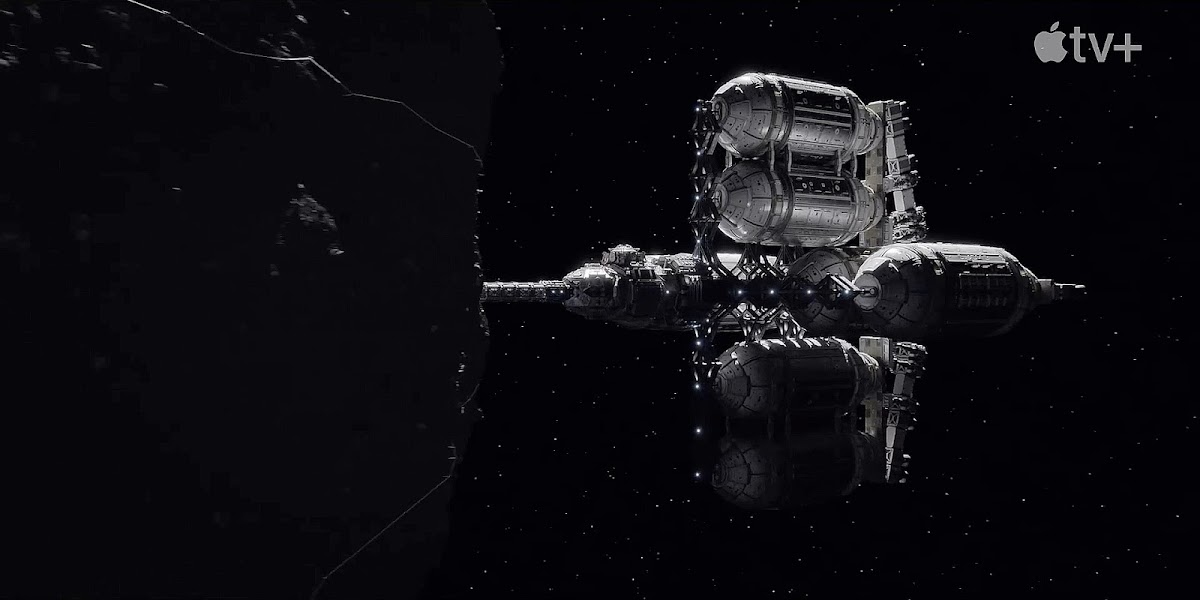 Yesterday Apple TV+ published a yet unlisted trailer for season 4 of For All Mankind alternate history sci-fi TV series, revealing asteroid mining will play a major role in season 4, set in 2003. The trailer also revealed more details about the soon-to-be "self-sustaining" international Happy Valley base on Mars, first depicted in the first teaser for season 4 a month ago.
Yesterday Apple TV+ published a yet unlisted trailer for season 4 of For All Mankind alternate history sci-fi TV series, revealing asteroid mining will play a major role in season 4, set in 2003. The trailer also revealed more details about the soon-to-be "self-sustaining" international Happy Valley base on Mars, first depicted in the first teaser for season 4 a month ago.
For All Mankind is exploring the idea of never ending space race if Soviets would have beaten US in the race for the Moon and the intention of the show is each season to jump about a decade further into the increasingly diverging reality of the show: in season 1, depicting alternate 1969 to 1974, both Soviets and US start building their separate bases near the lunar South pole; in season 2 (1983) both bases have been expanded and the superpowers compete for resources on the Lunar surface; in season 3 (1992 to 1995), Soviets and US are joined by a private company Helios and North Korea for a four way race to establish the first human base on Mars. Season 4 will start airing on November 10 on Apple TV+ and will depict the alternate 2003.
Here you can watch the trailer and see some HD images from it:
Happy Valley base on Mars:
Subscribe to:
Posts (Atom)





















